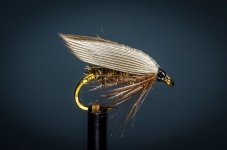I agree w/Chaz re: the Henryville, although I think a #16 is a little better match for the grannom than the #14. The grannom is one of those bugs that you often see in profusion if you see them at all. If you are fishing over trout that see quite a few guys as is often the case with the grannom, the fish tend to get "patterned" on a specific sized insect and they sometimes get more picky than usual. In situations like this, dropping down a single size can often make a significant difference in your success.
And this is coming from a guy who isn't all that big of a believer in precise hatch matching....
But the thing about the Henryville is you can pop it so it goes underneath the surface momentarily and have it briefly act as a wet fly and then false cast it a couple times to dry it off and fish it on top again. This can be very effective and, at least for me, doesn't work near as well when I try it with hairwing caddis dries.
The other thing I would say about the Henryville is that I tend to see most fly patterns as general templates to be adjusted and tweaked PRN. To that end, during the grannom I'll often tie a Henryville-style fly with the quill wings, etc., but replace the green body with a very dark brown body palmered with a medium to dark dun (instead of grizzly) hackle. I really don't know if it makes any difference to the fish, but it makes me happier and seems to work OK.




